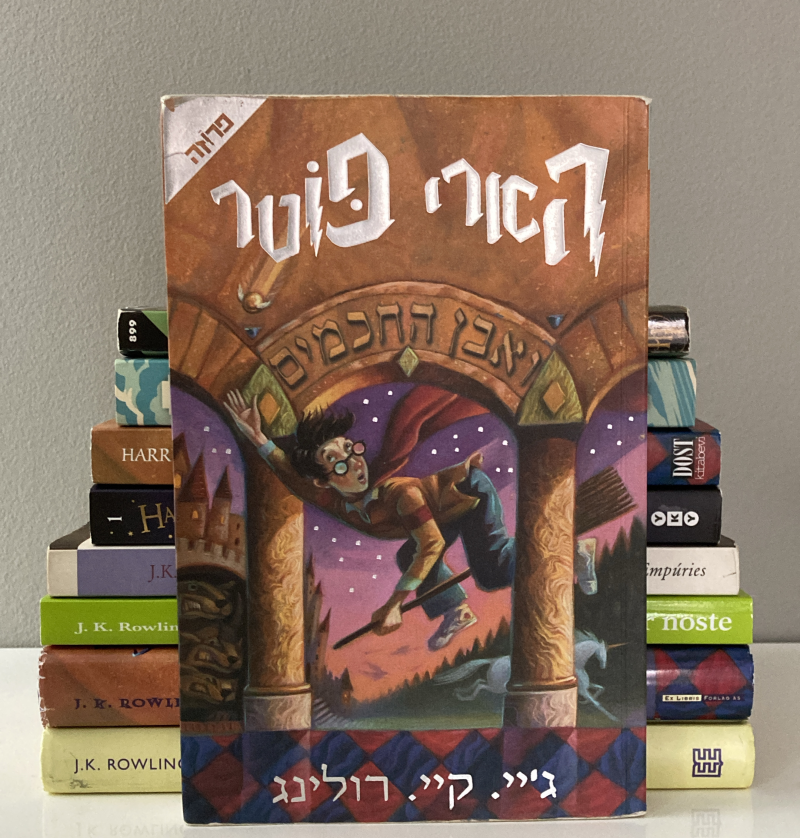On some level, Hebrew is an interesting choice for a translation of the Harry Potter series. The 20th-century revival of the language, which was in minimal use for some two thousand years, was a bit on the controversial side. For centuries it had been a holy language, reserved for the Tanakh, for prayer, and for religious discussion, but not for everyday tasks. Early on, some of the Jews in the Holy Land who were eager to establish a Jewish state advocated Yiddish as the common language of Israel—Hebrew was simply too holy. Ultimately, Hebrew won out. And by the turn of the century, even books about wizards and witches (Harry Potter!) ended up published in the language.
Another reason why translation into Hebrew is interesting is because the ancient language’s literary culture is really very young. There isn’t a ton of history of the language being used to express complex imagery outside of religious literature, and intertextuality is relatively restricted to the Bible and other well-known but extrascriptural religious texts. On top of that, for much of the 20th century the audience for Hebrew literature was dominated by non-native speakers who had picked up the language sometime after early childhood, and so the market for literature using intricate literary devices was limited as it catered to those non-native speakers.
Such circumstances did not leave much room for creativity. And, frankly, that’s reflected very typically in Hebrew-language fiction, in Hebrew-language music, in Hebrew-language poetry, and other forms of expression. Deep and complex ideas are expressed in the language, that’s for sure, but not in the most poetic of ways. This will undoubtedly change over time as generations of native Hebrew speakers continue to build a modern and unique literary culture.
Simplicity in translation, especially for those new to the Hebrew alphabet

But Harry Potter ve-Even haHochmīm is very much effected by this situation. Not only was it translated in the nascence of modern Hebrew literature, it also seems to cater to non-native learners. One of the many examples that seem to indicate this is the translation of “Remembrall”: kadōr hazikkarōn “memory ball.” It’s remarkably plain—almost uniquely plain among all the world’s translations—but the straightforward translation ensures that newcomers to Hebrew will not miss the reference.
Complicating matters for many readers is the Hebrew script. Not only do newcomers to the language almost invariably have to learn the alphabet from scratch, but vowels are not usually written, which can make it extra difficult to infer the meaning of neologisms.
The ancient script was invented before vowels had been conceptualized. If you think about it, vowels are simply tongue movements between consonants. Your tongue is moving, but it isn’t actually touching anything. It’s much easier to conceptualize consonants like “d” and “k,” because your tongue is touching a very specific spot. So those very tangible sounds were written down, but the movements between those sounds were not.
That’s a gross oversimplification of the situation. There are other factors that led to consonants being written before vowels, like the transition from logograms (like hieroglyphics) to consonants as well as Hebrew’s the triconsonantal root system of word derivation. But we don’t need to get into all the nitty-gritty just to say that vowels were invented later.
Needless to say, vowels were eventually invented and written down, but Hebrew, with its long tradition of writing without vowels, only uses them in specific situations. The phrase kadōr hazikkarōn, for example, is written <kdor hzikron>.
Drawing on Jewish traditions and literature
But all this does not stop Hebrew from getting creative in its own way in its translation of Harry Potter! As mentioned in the previous post, the Hebrew version of Harry Potter replaces Dumbledore’s preference for sherbet lemons with a preference for “krembo,” a chocolate-covered treat popular in Israel. And while the book’s use of the Hebrew language is not particularly intricate, it does draw ideas from the language’s ancient religious literature.
One example is the translation of “hags” in Chapter 5 of Philosopher’s Stone. The Hebrew version translates it into liliōt, “Liliths.” Lilith refers to a sort of demonic figure primarily in post-biblical literature (see “Lilith” at Jewish Encyclopedia). Conceived at some point in Jewish literature as Adam’s first wife, Lilith takes on human form (but is often winged as angels and demons are often conceived) and has some level of antipathy towards human children since, after all, they are the progeny of Eve, Adam’s other wife.

On the Spellman Spectrum, the Hebrew translation receives a score of 66.5. Expect an enjoyable and approachable reading experience if you know some Hebrew and want to pick up a copy of this translation! Don’t expect poetry, but that makes it great for an intermediate student of Hebrew who wants to practice and enjoy this book to its fullest.
Have you read Harry Potter in Hebrew? Let us know what you think of the translation, and let us know your favorite parts.

2 Pingbacks